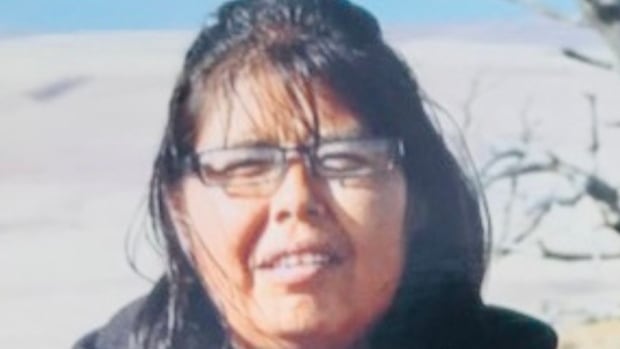When Martin Iron Shirt thinks of his sister, Lisa Red Young Man, he immediately remembers one thing in particular: she had an open door policy for those in need.
She didn’t have much. But when people came knocking, she would always give.
“She allowed them into her home. Gave them a place to sleep. She was always so friendly and smiling, joking around,” Iron Shirt said.
Life on Piikani Nation hadn’t been easy for Iron Shirt and Red Young Man, especially because they had grown up very poor.

But Iron Shirt saw his sister as being resilient and compassionate: whether working as a security guard for the nation or as a receptionist at Piikani Housing, she did it all with a friendly smile.
She loved her eight children and her “fur babies” — as a young girl, she adored her grandfather’s dog, Tiger.
“She always had a fight in her. She really loved her children. And, you know, as tough as life was for her, she still tried her best to give them the best life that she could provide for them,” Iron Shirt said.
Red Young Man struggled with addictions throughout her adult life. Two months before she died, a fire started at her home and quickly spread out of control. She lost everything.
“It almost seemed like from then it was just a downward spiral,” Iron Shirt said.
She left Piikani and went to find drugs in Lethbridge, Alta., where she overdosed.
Red Young Man was one of at least 1,706 Albertans who died of opioid poisoning last year. That works out, on average, to more than four deaths each and every day in 2023, the deadliest year on record for the province.
‘We’re losing knowledge’
The opioid crisis in Alberta has reached across populations and communities over the past number of years. But the First Nations population has been disproportionately affected.
The Alberta government has previously released data specific to Indigenous people in the province.
The last data release was in 2021. A spokesperson with the province said that data requires collaboration with First Nations across the province, which requires a significant amount of data verification and consultation prior to public release.
“This process is ongoing before the next report can be posted. These reports take longer to build as it is a full year of data that must be finalized before consultation with First Nations, data verification and preparation for private release can begin,” Hunter Baril wrote in a statement.
As of 2020, the data showed that the mortality rate for First Nations people due to opioid poisoning was around seven times higher than for non-First Nations people in Alberta.
Iron Shirt and his wife, Teddi, are no strangers to loss amid the opioid crisis. Along with Red Young Man, the husband and wife saw their kids get involved with drugs. Nearby communities like the Kainai Nation, also known as the Blood Tribe, began to declare states of emergencies. Others followed.
As the years went on, it grew worse and rose, with younger generations and whole families being wiped out by the drugs, Iron Shirt said.
“We’re losing so many of our young ones, and our older ones. We’re losing knowledge. We’re losing our elders. We’re losing generations of young individuals that are going to be our elders,” he said.

The fight to save lives
There were other losses in the family, too.
In 2019, Iron Shirt lost his brother to a methamphetamine overdose, while Teddi lost a niece who had just completed a treatment program, highlighting the unpredictable nature of recovery.
The level of loss has led to a sort of desensitization for the Iron Shirts. And despite being tasked as the strong ones who will often step up in times of loss, it remains an intensely personal fight.
“We have two sons out there still using. When we do get a call about a family member that has passed away from that, there’s an immediate fear I go through of getting that call about our sons, too,” Teddi said.
“That also just makes me want to keep on doing what we do with this awareness.”
For five years, the two have been running an overdose awareness event on the Piikani Nation called Honouring Our Loved Ones. It takes place on International Overdose Awareness Day, which takes place annually on Aug. 31.
The event, which involves a walk through the community, focuses on educating about the harms of drugs as well as available treatments and support services.
“You need to have what we call kímmapiiyipitssini — that means the true meaning of compassion and love. Because all of these individuals that are affected by the drugs, they’re all human first. And that’s part of the stigma that we see in our communities,” Iron Shirt said.
“We just want to end this stigma, because there’s nobody that’s not affected. We all know somebody, family, friend … relative. We’re all connected some way,” Terri said.

Dr. Esther Tailfeathers, a family physician on the Blood Tribe, attributes much of what has been taking place to widespread trauma and poverty in Indigenous communities. In her view, it’s exacerbated by a lack of culturally appropriate services. She said the situation requires a rethink on how to approach addiction.
“This mortality rate in a third-world country would be horrific. But this is Canada, and it’s happening here in Canada,” Tailfeathers said.
Lisa’s story is one of four personal stories in this series, A Toxic Year, which explores the growing number of opioid deaths in Alberta. More than four Albertans died per day, on average, in 2023, the deadliest year on record for the province. You can find the other stories here.


